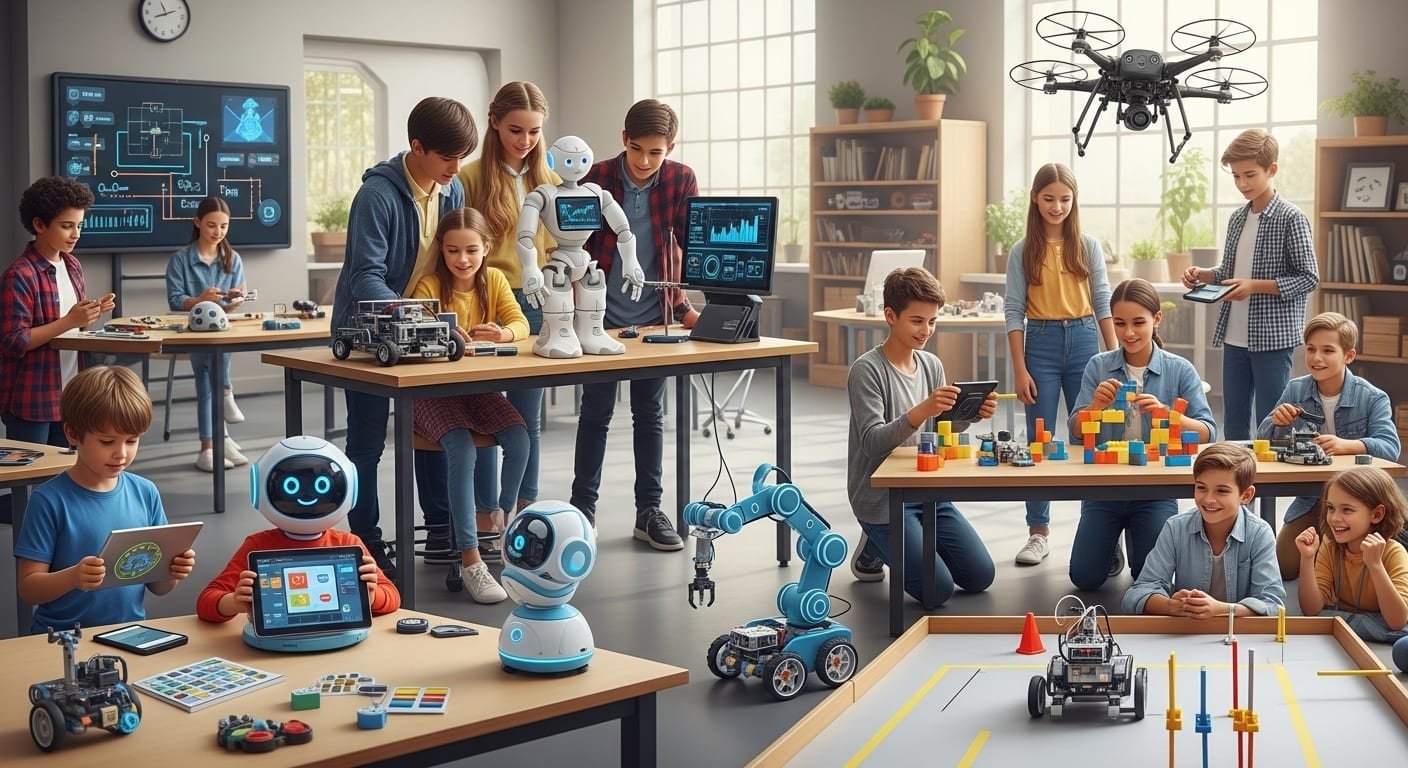AI Research
Educational Robot Market Size to Reach $5.9B by 2033: Growth Trends & Market Scope

Market Overview:
According to IMARC Group’s latest research publication, “Educational Robot Market by Component (Hardware, Software), Product Type (Humanoid, Non-Humanoid), End-User (K-12, Universities, and Others), and Region 2025-2033“, the global educational robot market size reached USD 1.9 Billion in 2024. Looking forward, IMARC Group expects the market to reach USD 5.9 Billion by 2033, exhibiting a growth rate (CAGR) of 13.6% during 2025-2033.
This detailed analysis primarily encompasses industry size, business trends, market share, key growth factors, and regional forecasts. The report offers a comprehensive overview and integrates research findings, market assessments, and data from different sources. It also includes pivotal market dynamics like drivers and challenges, while also highlighting growth opportunities, financial insights, technological improvements, emerging trends, and innovations. Besides this, the report provides regional market evaluation, along with a competitive landscape analysis.
How AI is Reshaping the Future of Educational Robot Market
- Generative AI is revolutionizing education by creating intelligent, adaptive learning companions that enhance the student experience, with AI teachers offering personalized learning paths that adjust content delivery based on individual student needs, transforming traditional classroom interactions through sophisticated machine learning algorithms that analyze student performance in real-time.
- Machine learning systems are dramatically improving educational engagement and retention rates, with advanced AI-powered robots now capable of recognizing student emotions and adjusting teaching approaches accordingly, leading to improved learning outcomes across diverse age groups and educational levels in schools worldwide.
- AI and machine learning are making robots smarter and more versatile, enabling educational robots to process complex student queries instantly, adapt curriculum delivery methods, and provide immediate feedback through natural language processing capabilities that make learning more interactive and effective.
- Strategic partnerships between technology companies and educational institutions are accelerating innovation, with major robotics firms collaborating with schools to develop specialized educational content, while universities integrate programmable robots for advanced research purposes and hands-on learning experiences that prepare students for future careers.
- Universities are using programmable robots for research purposes, driven by integration of artificial intelligence technology and hands-on learning approaches, enabling students to gain practical experience with cutting-edge robotics technology while conducting advanced research projects that push the boundaries of educational innovation.
Get Your Free “Educational Robot Market” Sample PDF Report Now!
Key Trends in the Educational Robot Market
- Hardware components dominate the market landscape, capturing the largest market share as educational institutions prioritize tangible, interactive learning tools that students can physically manipulate, with schools investing heavily in durable robotic platforms that withstand classroom environments while delivering consistent educational value.
- Non-humanoid robots lead the product segment transformation, representing the majority market share as educators favor specialized teaching robots designed for specific subjects like mathematics, science, and coding, offering cost-effective solutions that focus on educational functionality rather than human-like appearance or social interaction capabilities.
- The K-12 education segment drives market expansion, accounting for the largest end-user share due to growing recognition of STEM education importance, with elementary and secondary schools increasingly adopting robotic teaching tools to enhance student engagement in science, technology, engineering, and mathematics subjects.
- The secondary education segment held the largest share of 39.3% in 2024, as middle and high schools use more educational robots where students learn complex STEM concepts, including robotics, coding, engineering, and artificial intelligence, demonstrating the effectiveness of hands-on robotic learning in advanced educational settings.
- Asia Pacific regional dominance continues strengthening, holding the largest market share due to substantial government investments in educational technology, high smartphone penetration rates that complement robotic learning platforms, and strong cultural emphasis on technological advancement in education systems across countries like China, Japan, and South Korea.
Growth Factors in the Educational Robot Market
- Digital transformation acceleration is reshaping classroom experiences, with educational institutions rapidly adopting interactive robotic teaching assistants that deliver personalized instruction, while advanced sensors and AI capabilities enable robots to assess student understanding in real-time and adjust lesson difficulty accordingly for optimal learning outcomes.
- STEM education initiatives are creating unprecedented demand opportunities, as governments worldwide mandate science, technology, engineering, and mathematics curriculum improvements, with educational robots providing hands-on learning experiences that make complex concepts more accessible and engaging for students across all grade levels.
- Remote learning capabilities are expanding market applications significantly, with educational robots offering consistent teaching quality regardless of physical location, enabling schools to maintain educational continuity during disruptions while providing students with interactive learning experiences that traditional online education methods cannot deliver effectively.
- Cost-effectiveness advantages are driving institutional adoption decisions, as educational robots eliminate recurring expenses associated with traditional teaching materials, provide long-term educational value through software updates and curriculum expansions, while offering scalable solutions that serve multiple classrooms and subjects simultaneously.
- Workforce preparation demands are accelerating market growth, with educational institutions recognizing the critical need to prepare students for technology-driven careers, while robotic programming and interaction skills become essential competencies for future employment in increasingly automated industries and emerging technology sectors.
Ask analyst of customized report: https://www.imarcgroup.com/request?type=report&id=1900&flag=E
Leading Companies Operating in the Global Educational Robot Market Industry:
- Adele Robots
- Aisoy Robotics
- Arrick Robotics
- Blue Frog Robotics
- DST Robot Co.
- Hanson Robotics
- Idmind
- Macco Robotics
- Pal Robotics
- Primo Toys
- Probotics America
- Qihan Technology Co.
- Robobuilder
- Robotis
- Softbank Robotics Corp.
Educational Robot Market Report Segmentation:
Breakup by Component:
Breakup by Product Type:
Breakup by End-User:
Regional Insights:
- North America (United States, Canada)
- Asia Pacific (China, Japan, India, South Korea, Australia, Indonesia, Others)
- Europe (Germany, France, United Kingdom, Italy, Spain, Russia, Others)
- Latin America (Brazil, Mexico, Others)
- Middle East and Africa
Recent News and Developments in Educational Robot Market
- January 2025: SoftBank Robotics announced expanded educational partnerships with over 500 schools globally, deploying humanoid robots in classrooms to assist with language learning and social skill development, while integrating advanced AI capabilities that adapt teaching methods based on individual student progress and engagement levels.
- February 2025: Leading educational technology companies launched collaborative initiatives with universities to develop specialized robotic teaching assistants for STEM subjects, focusing on personalized learning experiences that combine artificial intelligence with hands-on robotics training for students pursuing engineering and technology degrees.
- March 2025: Government education departments in several Asian countries announced substantial funding increases for educational robotics programs, allocating resources to equip thousands of schools with interactive teaching robots designed to enhance science and mathematics instruction while preparing students for technology-focused careers.
- January 2025: Major robotics manufacturers introduced new cost-effective educational robot models specifically designed for K-12 institutions, featuring simplified programming interfaces, enhanced safety features, and comprehensive curriculum packages that enable teachers to integrate robotic learning across multiple subjects without requiring extensive technical expertise.
Research Methodology:
The report employs a comprehensive research methodology, combining primary and secondary data sources to validate findings. It includes market assessments, surveys, expert opinions, and data triangulation techniques to ensure accuracy and reliability.
Note: If you require specific details, data, or insights that are not currently included in the scope of this report, we are happy to accommodate your request. As part of our customization service, we will gather and provide the additional information you need, tailored to your specific requirements. Please let us know your exact needs, and we will ensure the report is updated accordingly to meet your expectations.
About Us:
IMARC Group is a global management consulting firm that helps the world’s most ambitious changemakers to create a lasting impact. The company provide a comprehensive suite of market entry and expansion services. IMARC offerings include thorough market assessment, feasibility studies, company incorporation assistance, factory setup support, regulatory approvals and licensing navigation, branding, marketing and sales strategies, competitive landscape and benchmarking analyses, pricing and cost research, and procurement research.
Contact Us:
IMARC Group
134 N 4th St. Brooklyn, NY 11249, USA
Email: [email protected]
Tel No:(D) +91-120-433-0800
United States: +1-201-971-6302
AI Research
Historic US-UK deal to accelerate AI drug discovery, quantum and nuclear research

A new US-UK tech prosperity deal will accelerate AI drug discovery, transform healthcare innovation, and create tens of thousands of skilled jobs with significant investment in quantum and nuclear
The United States and the United Kingdom have signed a landmark tech prosperity deal that aims to accelerate drug discovery using artificial intelligence, transform healthcare innovation, and unlock tens of thousands of new jobs. Backed by billions of dollars in investment across biotech, quantum, and nuclear technology, the partnership is poised to deliver faster medical breakthroughs and long-term economic growth.
£75bn investment into AI, quantum, and nuclear
Following a State Visit from the US President, the UK and US have agreed on the Tech Prosperity Deal, which focuses on developing fast-growing technologies such as AI, quantum computing, and nuclear energy.
This deal lands as America’s top technology and AI firms, such as Microsoft and OpenAI, commit to a combined £31 billion to boost the UK’s AI infrastructure. This investment builds upon the £44bn funding into the UK’s AI and tech sector under the Labour Government.
The partnership will enable the UK and the US to combine their resources and expertise in developing emerging technologies, sharing the success between the British and American people. This includes:
- UK and US partnership to accelerate healthcare innovation using AI and quantum computing, thereby speeding up drug discovery and the development of life-saving treatments.
- Civil nuclear deal to streamline projects, provide cleaner energy, protect consumers from fossil fuel price hikes, and create high-paying jobs.
- Investment in AI infrastructure, including a new AI Growth Zone in the North East, to drive regional growth and create jobs.
- Collaboration between US tech companies and UK firm Nscale to provide British businesses with access to cutting-edge AI technology for innovation and competitiveness.
Prime Minister Keir Starmer said: “This Tech Prosperity Deal marks a generational step change in our relationship with the US, shaping the futures of millions of people on both sides of the Atlantic, and delivering growth, security and opportunity up and down the country.
By teaming up with world-class companies from both the UK and US, we’re laying the foundations for a future where together we are world leaders in the technology of tomorrow, creating highly skilled jobs, putting more money in people’s pockets and ensuring this partnership benefits every corner of the United Kingdom.”
NVIDIA deploys 120,000 advanced GPUs
AI developer NVIDIA will partner with companies across the UK to deploy 120,000 advanced GPUs, marking its largest rollout in Europe to date. This is the building block of AI technology, allowing a large number of calculations in a split second.
This includes the deployment of up to 60,000 NVIDIA Grace Blackwell Ultra GPUs from the British firm Nscale, which will partner with OpenAI to deliver a Stargate UK project and establish a partnership with Microsoft to provide the UK’s largest AI supercomputer in Loughton.
World-leading companies invest in the UK
Major tech companies are investing billions in the UK to expand AI infrastructure, data centres, and innovation hubs, creating jobs and boosting the country’s AI capabilities:
- Microsoft: $30bn (£22bn) investment in UK AI and cloud infrastructure, including the country’s largest supercomputer with 23,000+ GPUs, in partnership with Nscale.
- Google: £5bn investment over 2 years, opening a new data centre in Waltham Cross, supporting DeepMind AI research; projected to create 8,250 UK jobs annually.
- CoreWeave: £1.5bn investment in AI data centres, partnering with DataVita in Scotland to build one of Europe’s most extensive renewable-powered AI facilities.
- Salesforce: $2bn (£1.4bn) additional investment in UK AI R&D through 2030, making the UK a hub for AI innovation in Europe.
- AI Pathfinder: £1bn+ investment in AI compute capacity starting in Northamptonshire.
- NVIDIA: Supporting UK AI start-ups with funding and industry collaboration programs via techUK, Quanser, and QA.
- Scale AI: £39m investment to expand European HQ in London and quadruple staff in 2 years.
- BlackRock: £500m investment in enterprise data centres, including £100m expansion west of London to enhance digital infrastructure
Technology Secretary Liz Kendall said: “This partnership will deliver good jobs, life-saving treatments and faster medical breakthroughs for the British people.
Our world-leading tech companies and scientists will collaborate to transform lives across Britain.
This is a vote of confidence in Britain’s booming AI sector – building on British success stories such as Arm, Wayve and Google Deepmind – that will boost growth and deliver tens of thousands of skilled jobs.”
AI Research
Google invests £5bn to help power the UK’s AI economy

Demis Hassabis, co-founder and chief executive of Google DeepMind (Credit: Ange.original)
Google has opened a data centre in Hertfordshire to meet growing demand for AI services, as part of a two-year £5bn investment in the UK.
The centre in Waltham Cross, opened by chancellor Rachel Reeves, encompasses Google DeepMind with its AI research in science and healthcare, and will help the UK develop its AI economy by advancing AI breakthroughs and supporting around 8,250 jobs.
It is part of a £5bn investment including capital expenditure, research and development, and related engineering.
Reeves said: “Google’s £5bn investment is a powerful vote of confidence in the UK economy and the strength of our partnership with the US, creating jobs and economic growth for years to come.”
Google is investing to support people across the UK to gain the skills for AI adoption and is part of an industry group, announced by the government in July 2025, to train 7.5 million people by 2030.
Demis Hassabis, co-founder and chief executive of Google DeepMind, said: “We founded DeepMind in London because we knew the UK had the potential and talent to be a global hub for pioneering AI.
“The UK has a rich history of being at the forefront of technology – from Lovelace to Babbage to Turing – so it’s fitting that we’re continuing that legacy by investing in the next wave of innovation and scientific discovery in the UK.”
Google will establish a community fund, managed by Broxbourne Council, to support local economic development.
Ruth Porat, president and chief investment officer at Alphabet and Google, said: “With today’s announcement, Google is deepening our roots in the UK and helping support Great Britain’s potential with AI to add £40bn to the economy by 2030 while also enhancing critical social services.
“Google’s investment in technical infrastructure, expanded energy capacity and job-ready AI skills will help ensure everyone in Broxbourne and across the whole of the UK stays at the cutting-edge of global tech opportunities.”
The news follows announcements from pharmaceutical giants Merck and AstraZeneca that they are pulling out of the UK.
Merck, known as MSD in Europe, halted plans to build a £1bn research centre under construction in London and is cutting more than 100 scientific staff, citing concerns about the UK’s commercial environment.
Meanwhile, AstraZeneca has paused a planned £200 million investment in its Cambridge research site, which was expected to create thousands of jobs.
This is a blow for the government, which is seeking to boost economic growth and attract investment to life sciences, with Wes Streeting, health secretary, pledging to make Britain a “powerhouse” for the sector.
The government’s Life Sciences Sector Plan, published in July 2025, sets an ambition to harness scientific innovation for economic growth, which includes making the UK “an outstanding place to start, scale and invest”.
Commenting on Google’s investment, Nick Lansman, chief executive and founder of the Health Tech Alliance, said: “This kind of scalable computing and world‑class R&D will help health tech innovators accelerate discovery, deployment and safe adoption across the NHS, supporting the UK’s ambition to be a global hub for life sciences growth.”
AI Research
5 steps for deploying agentic AI red teaming

AI-based agentic sources of security exploits aren’t new. The Open Worldwide Application Security Project (OWASP) published a paper that examines all kinds of agentic AI security issues with specific focus on model and application architecture and how multiple agents can collaborate and interact. It reviewed how users of various general-purpose agent frameworks such as LangChain, CrewAI and AutoGPT should better protect their infrastructure and data. Like many other OWASP projects, its focus is on how application development can incorporate better security earlier in the software lifecycle.
Andy Swan at Gray Swan AI led a team to publish an academic paper on AI agent security challenges. In March, they pitted 22 frontier AI agents in 44 realistic deployment scenarios that resulted in observing the effects of almost two million prompt injection attacks. Over 60,000 attacks were successful, “suggesting that additional defenses are needed against adversaries. This effort was used to create an agent red teaming benchmark and framework to evaluate high-impact attacks.” The results revealed deep and recurring failures: agents frequently violated explicit policies, failed to resist adversarial inputs, and performed high-risk actions across domains such as finance, healthcare, and customer support. “These attacks proved highly transferable and generalizable, affecting models regardless of size, capability, or defense strategies.”
Part of the challenge for assembling effective red team forays into your infrastructure is that the entire way incidents are discovered and mitigated is different when it comes to dealing with agentic AI. “From an incident management perspective, there are some common elements between agents and historical attacks in terms of examining what data needs to be protected,” Myles Suer of Dresner Advisory, an agentic AI researcher, tells CSO. “But gen AI stores data not in rows and columns but in chunks and may be harder to uncover.” Plus, time is of the essence: “The time between vulnerability and exploit is exponentially shortened thanks to agentic AI,” Bar-El Tayouri, the head of AI security at Mend.io, tells CSO.
-

 Business3 weeks ago
Business3 weeks agoThe Guardian view on Trump and the Fed: independence is no substitute for accountability | Editorial
-
Tools & Platforms1 month ago
Building Trust in Military AI Starts with Opening the Black Box – War on the Rocks
-

 Ethics & Policy2 months ago
Ethics & Policy2 months agoSDAIA Supports Saudi Arabia’s Leadership in Shaping Global AI Ethics, Policy, and Research – وكالة الأنباء السعودية
-

 Events & Conferences4 months ago
Events & Conferences4 months agoJourney to 1000 models: Scaling Instagram’s recommendation system
-

 Jobs & Careers3 months ago
Jobs & Careers3 months agoMumbai-based Perplexity Alternative Has 60k+ Users Without Funding
-

 Podcasts & Talks2 months ago
Podcasts & Talks2 months agoHappy 4th of July! 🎆 Made with Veo 3 in Gemini
-

 Education2 months ago
Education2 months agoMacron says UK and France have duty to tackle illegal migration ‘with humanity, solidarity and firmness’ – UK politics live | Politics
-

 Education3 months ago
Education3 months agoVEX Robotics launches AI-powered classroom robotics system
-

 Podcasts & Talks2 months ago
Podcasts & Talks2 months agoOpenAI 🤝 @teamganassi
-

 Funding & Business3 months ago
Funding & Business3 months agoKayak and Expedia race to build AI travel agents that turn social posts into itineraries















